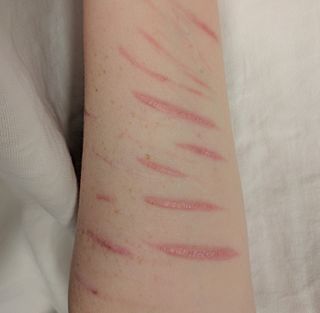
Cognitive behavioral therapy (CBT) is a psycho-social intervention that aims to reduce symptoms of various mental health conditions, primarily depression and anxiety disorders. Cognitive behavioral therapy is one of the most effective means of treatment for substance abuse and co-occurring mental health disorders. CBT focuses on challenging and changing cognitive distortions and their associated behaviors to improve emotional regulation and develop personal coping strategies that target solving current problems. Though it was originally designed to treat depression, its uses have been expanded to include many issues and the treatment of many mental health conditions, including anxiety, substance use disorders, marital problems, ADHD, and eating disorders. CBT includes a number of cognitive or behavioral psychotherapies that treat defined psychopathologies using evidence-based techniques and strategies.

Major depressive disorder (MDD), also known as clinical depression, is a mental disorder characterized by at least two weeks of pervasive low mood, low self-esteem, and loss of interest or pleasure in normally enjoyable activities. Introduced by a group of US clinicians in the mid-1970s, the term was adopted by the American Psychiatric Association for this symptom cluster under mood disorders in the 1980 version of the Diagnostic and Statistical Manual of Mental Disorders (DSM-III), and has become widely used since.

Self-harm is intentional conduct that is considered harmful to oneself. This is most commonly regarded as direct injury of one's own skin tissues usually without a suicidal intention. Other terms such as cutting, self-injury, and self-mutilation have been used for any self-harming behavior regardless of suicidal intent. Common forms of self-harm include damaging the skin with a sharp object or by scratching, hitting, or burning. The exact bounds of self-harm are imprecise, but generally exclude tissue damage that occurs as an unintended side-effect of eating disorders or substance abuse, as well as societally acceptable body modification such as tattoos and piercings.

Suicide prevention is a collection of efforts to reduce the risk of suicide. Suicide is often preventable, and the efforts to prevent it may occur at the individual, relationship, community, and society level. Suicide is a serious public health problem that can have long-lasting effects on individuals, families, and communities. Preventing suicide requires strategies at all levels of society. This includes prevention and protective strategies for individuals, families, and communities. Suicide can be prevented by learning the warning signs, promoting prevention and resilience, and committing to social change.
Relational aggression, alternative aggression, or relational bullying is a type of aggression in which harm is caused by damaging someone's relationships or social status.

Suicidal ideation, or suicidal thoughts, is the thought process of having ideas, or ruminations about the possibility of completing suicide. It is not a diagnosis but is a symptom of some mental disorders, use of certain psychoactive drugs, and can also occur in response to adverse life events without the presence of a mental disorder.
David Percy Shaffer was a South African-born British-American physician and pediatrician. He was the Irving Philips Professor of Child Psychiatry in the Departments of Psychiatry and Pediatrics, at Columbia University's College of Physicians and Surgeons in New York City, now the Columbia University Vagelos College of Physicians and Surgeons. Shaffer was also the chief of pediatric psychiatry at New York–Presbyterian Hospital and chief of the Division of Child and Adolescent Psychiatry, New York State Psychiatric Institute. He was the former spouse of renowned British-American journalist Anna Wintour.
A major depressive episode (MDE) is a period characterized by symptoms of major depressive disorder. Those affected primarily exhibit a depressive mood for at least two weeks or more, and a loss of interest or pleasure in everyday activities. Other symptoms can include feelings of emptiness, hopelessness, anxiety, worthlessness, guilt, irritability, changes in appetite, difficulties in concentration, difficulties remembering details, making decisions, and thoughts of suicide. Insomnia or hypersomnia and aches, pains, or digestive problems that are resistant to treatment may also be present.
Bipolar II disorder (BP-II) is a mood disorder on the bipolar spectrum, characterized by at least one episode of hypomania and at least one episode of major depression. Diagnosis for BP-II requires that the individual must never have experienced a full manic episode. Otherwise, one manic episode meets the criteria for bipolar I disorder (BP-I).
Youth suicide is when a young person, generally categorized as someone below the legal age of majority, deliberately ends their own life. Rates of youth suicide and attempted youth suicide in Western societies and other countries are high. Youth suicide attempts are more common among girls, but adolescent males are the ones who usually carry out suicide. Suicide rates in youths have nearly tripled between the 1960s and 1980s. For example, in Australia suicide is second only to motor vehicle accidents as its leading cause of death for people aged 15 to 25.

Suicide is the act of intentionally causing one's own death. Mental disorders, physical disorders, and substance abuse are risk factors. Some suicides are impulsive acts due to stress, relationship problems, or harassment and bullying. Those who have previously attempted suicide are at a higher risk for future attempts. Effective suicide prevention efforts include limiting access to methods of suicide such as firearms, drugs, and poisons; treating mental disorders and substance abuse; careful media reporting about suicide; improving economic conditions; and dialectical behaviour therapy (DBT). Although crisis hotlines are common resources, their effectiveness has not been well studied.

Major depressive disorder, often simply referred to as depression, is a mental disorder characterized by prolonged unhappiness or irritability. It is accompanied by a constellation of somatic and cognitive signs and symptoms such as fatigue, apathy, sleep problems, loss of appetite, loss of engagement, low self-regard/worthlessness, difficulty concentrating or indecisiveness, or recurrent thoughts of death or suicide.

Gender differences in suicide rates have been shown to be significant. There are different rates of suicides and suicidal behavior between males and females. While females more often have suicidal thoughts, males die by suicide more frequently. This discrepancy is also known as the gender paradox in suicide.
Research has found that attempted suicide rates and suicidal ideation among lesbian, gay, bisexual, and transgender (LGBT) youth are significantly higher than among the general population.
Bullying suicide are considered together when the cause of suicide is attributable to the victim having been bullied, either in person or via social media. Writers Neil Marr and Tim Field wrote about it in their 2001 book Bullycide: Death at Playtime.

Suicide in the military is the act of ending one's life during or after a career in the armed forces.
Ellen Frank is a psychologist and Distinguished Professor Emeritus of Psychiatry and Distinguished Professor of Psychology at the University of Pittsburgh. She is known in the field of Psychotherapy as one of the developers of Interpersonal and Social Rhythm Therapy, which aims to treat bipolar disorder by correcting disruptions in the circadian rhythm while promoting increased regularity of daily social routines. Frank is the co-founder and Chief Scientific Officer of HealthRhythms, a company that uses mobile technology to monitor the health and mental health of clients, facilitate the detection of changes in their status, and better manage mental health conditions.
In colleges and universities in the United States, suicide is one of the most common causes of death among students. Each year, approximately 24,000 college students attempt suicide while 1,100 students succeed in their attempt, making suicide the second-leading cause of death among U.S. college students. Roughly 12% of college students report the occurrence of suicide ideation during their first four years in college, with 2.6% percent reporting persistent suicide ideation. 65% of college students reported that they knew someone who has either attempted or died by suicide, showing that the majority of students on college campuses are exposed to suicide or suicidal attempts.
Suicide and trauma is the increased risk of suicide that is caused by psychological trauma.
Youth suicide in India is when young Indian people deliberately end their own life. People aged 15 to 24 years have the highest suicide rate in India, which is consistent with international trends in youth suicide. 35% of recorded suicides in India occur in this age group. Risk factors and methods of youth suicide differ from those in other age groups.









